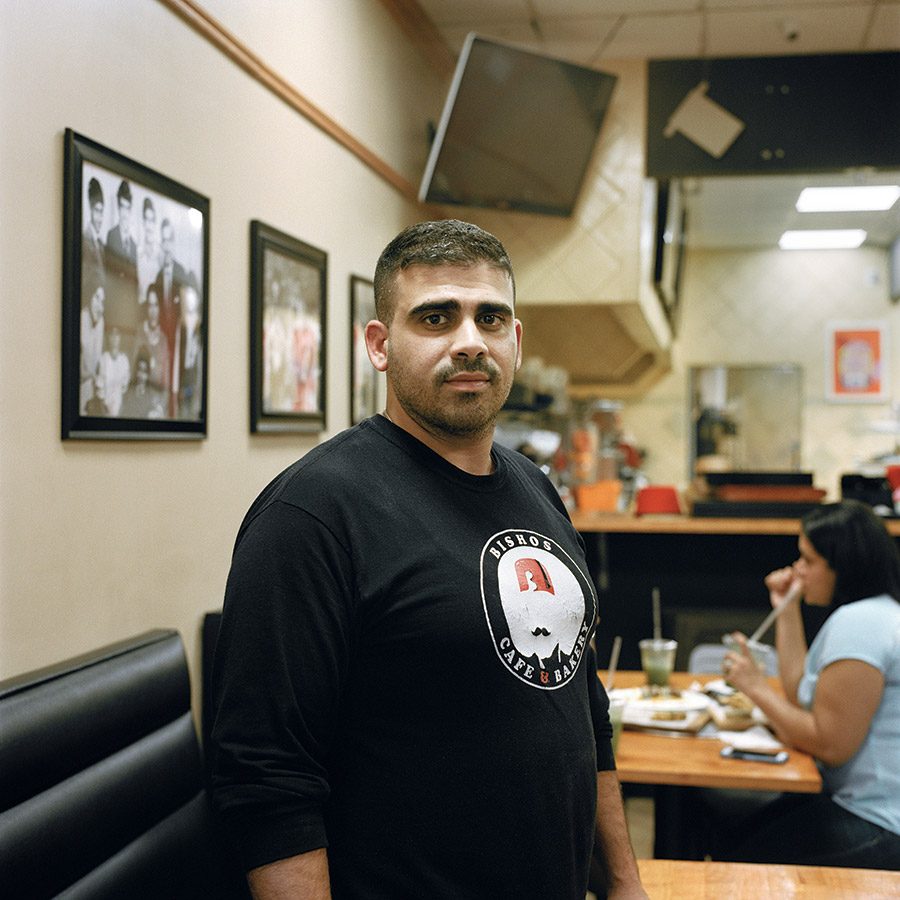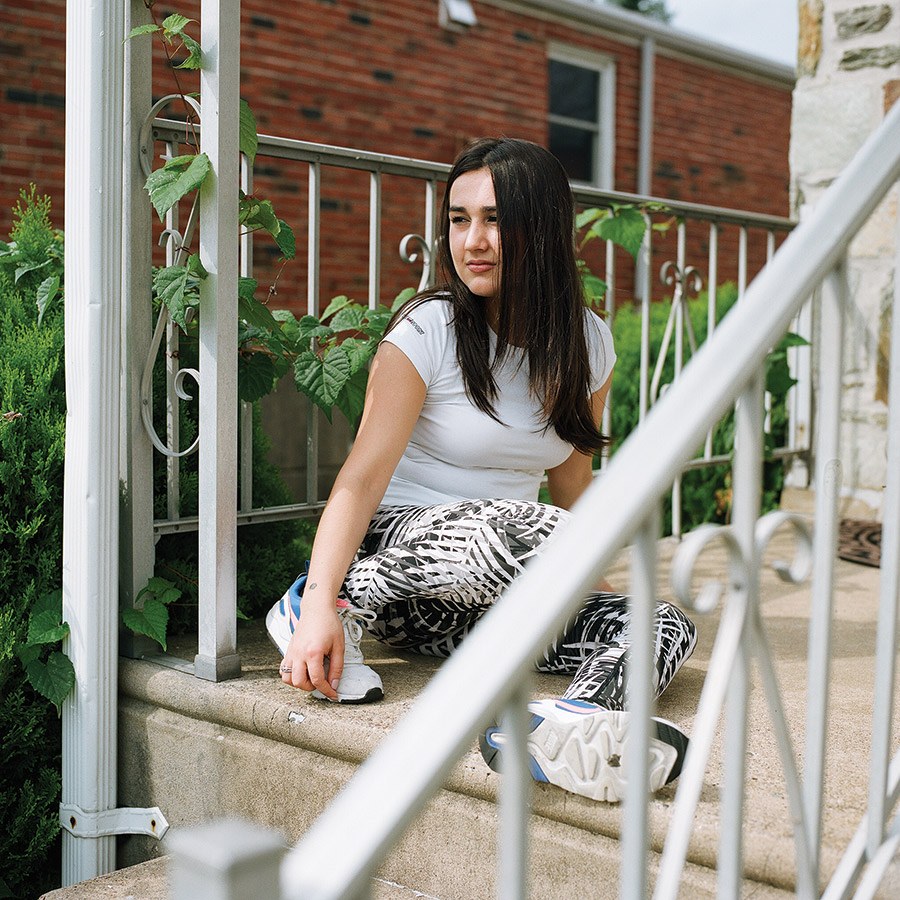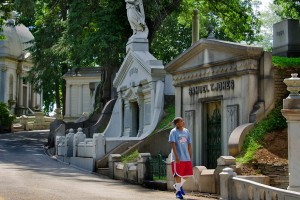Meet the New Northeast Philadelphia
How a staid, frayed, forgotten stretch of Philly has become the most interesting (hopeful, complicated, delicious) place in the city.

Jose and Maria Del Carmen Maldonado, 47 and 42, respectively, with sons Jose, six, and Jose, 16. The family came to Philadelphia last year after gaining asylum from the tumult in their home country, Venezuela. Both Maria Del Carmen and Jose used to work in human resources; now, she is cleaning homes, and he is in construction. It was hard to leave their family and comfortable house behind, Maria Del Carmen says — and yet she feels like Philly is their home already.
One recent Saturday morning, on a well-trafficked strip of Castor Avenue in Oxford Circle, a Chinese Buddhist, a Hindu of Guyanese descent, a Muslim from Morocco, and a Filipino Christian opened a new thrift store. Each offered her own blessing on the place, and then, voilà: The building that had been home for 69 years to Jewish-owned Singers Appliances was now officially the Exchange, offering a collection of gently used goods and, also, English classes for immigrants.
About an hour into the store’s new life, State Representative Jared Solomon (Jewish, grew up in the neighborhood, above his grandfather’s butcher shop) popped in, as did two Spanish-speaking Latino families, an English-speaking black family, a Mandarin-speaking Chinese woman, and one white American-born reporter who sometimes can recall a little high-school French.

Chuong Le, 34, came to Philadelphia in 2005 from Vietnam, where he was studying to be an engineer. When he got here, “I started over. I went to community college, then Temple. I worked, in business, nine to five. But I didn’t get along so well with the nine-to-five track.” Today, as a business owner, he has a schedule more like eight to midnight, but he’s happier. He owns four restaurants (including Pho Saigon on Bustleton Avenue and the new Saigon Noodle Bar in Chestnut Hill) and a staffing agency, employing some 150 people in total.
What seemed to me to be an absolutely astounding mesh of humanity browsing table lamps and baby clothes is, it turns out, actually not so remarkable for this Lower Northeast neighborhood (population roughly 60,000), which is sandwiched by Mayfair, Lawncrest and Rhawnhurst and which has, in just a couple decades, morphed into one of the most ethnically (and religiously and linguistically) diverse spots in the city. This is a place where nearly half the residents over the age of five speak a language other than English at home, and where it’s not unusual to see, for instance, a group of Muslim men in thobes passing a Brazilian steakhouse and an Indian Pentecostal church on the way to the Islamic Center.
It’s also one of the best spots in the city to be hungry: Within a few blocks, you can find, yes, authentic Brazilian fare as well as Portuguese, Chinese, Vietnamese, Indian, Jamaican, Middle Eastern, Latin American and Italian. Also, cheesesteaks.
This is a relatively new development — so many ethnic groups living (and eating) cheek-to-jowl amongst the tidy rowhomes, twins, and suburban-style single-family houses with their green strips of front yard. For the second half of the 20th century, the neighborhood was comprised of Irish Catholic and Jewish middle-class families. That the place now reminds you of the opening ceremonies at the Olympics is mostly thanks to the dual-thrust forces of the Old Guard’s aging out and moving on and a robust surge of immigration in Philadelphia. How robust? A report from Pew Charitable Trusts told us this past June that the number of immigrants in our city has skyrocketed 69 percent since 2000. Fifteen percent of us are immigrants right now; in Oxford Circle, where the housing stock is decent and affordable, that number is closer to 30 percent. And unlike in some other Northeast neighborhoods that have high concentrations of people from one or two places, here, the newcomers hail from a whole catalog of countries, from every continent but Australia and Antarctica.

Susana Ramos (fourth from left) and her family gather for worship at St. William Church in Lawncrest, which offers Spanish, Haitian and Pakistani Masses every Sunday. Ramos, 55, arrived from Cuba seven years ago, joining one of her three daughters who had already immigrated. There were no jobs for her daughters back home, she says, though one was a dentist and one worked in computer science. Today, all three daughters are here and working — including Suset, second from left, who works as a dental assistant — while Ramos helps care for her grandchildren, Lauren, eight, and Lian and Luis, both nine.
Not surprisingly, this seismic shift has brought with it a slew of challenges — the sorts you’re thinking of, like xenophobia, and also ones you’re not, like how to organize a trash pickup on your block when your block speaks six different languages. (Of course, that’s nothing compared to the 31 languages spoken at Spruance, the local K-8 school.) One hears stories of old-timers grumbling about new neighbors and missing the good old days when everything looked fresher and richer here — about the plethora of, say, nail-salon start-ups. There’s friction between the recent-immigrant groups, too: One young Palestinian-American I spoke to wasn’t so wild about the Chinese or some Syrian refugees, who he felt expected handouts; some Chinese business owners, meantime, have felt targeted by complaints about store hours from neighbors. And so on.

Mingchu Pearl Huynh, 54, is president of the eight-month-old Northeast Philadelphia Chinese Association (NEPCA), which is based in Oxford Circle and aims to serve the various needs of the Asian community and foster connection between those residents and their city. “It is so difficult for the Chinese people who have just moved into the neighborhood,” says Huynh, who herself arrived in Lawncrest in 2010. Huynh runs multiple NEPCA message boards through which she helps inform some of the 11,000 Chinese people living in the Northeast of everything from neighborhood news to parenting seminars she’s helped organize at the local library. “And we are just getting started,” she says.
But in and amidst these issues and other struggles, there’s a new energy, too — the type of energy that comes with the rare chance to reimagine a place and, maybe, an opportunity to rebrand this neighborhood as the most accessible, most culturally dynamic borough in the city. You know, offers Chuong Le, a Vietnamese immigrant who owns the neighborhood’s year-old Pho Saigon restaurant — “something like Queens.”
“We knew this moment was coming,” says Andréa Hodge. She’s the economic development associate for Oxford Circle Christian Community Development Association (OCCCDA), the nonprofit that runs the Exchange (among myriad other educational and business-development programs), and the moment she’s talking about is a sudden sense of forward motion — new bursts of interest coalescing among the neighbors, the businesses, the civic boosters and even the media, which has written lately about the area’s food scene (this magazine and the Inquirer), as well as the experiences of its immigrants and refugees and the tenuous economic stability here (Next City). Maybe you also saw the New York Times story last summer highlighting this area — and Philly itself — as a place where the American dream actually feels attainable.

“Sure, I am an immigrant,” says Bishara Kuttab, 30, “but I like the word ‘international.’” Born and raised in Jerusalem, Kuttab came to Philly often to visit family before moving here two years ago. Last year, he opened Bishos Middle Eastern Cuisine. “I’m happy with the types of people I see here,” Kuttab says. “But I’d say that this is still a marginalized area — marginalized by everyone from the media to the city to event planners. And our international community isn’t poor. The majority of people here are working-class, middle-class.” Still, he says, he’s pleased with the initiatives that are ramping up in the business community.
That’s not all: Last spring, the city chose Oxford Circle as the site for “Passport PHL,” an initiative spotlighting ethnic restaurants. (Each was owned by an immigrant, including Le’s Pho Saigon.) The city has, in fact, ramped up efforts in the economic corridors, bolstering businesses with grants for cameras and facade improvements — and, the mayor’s office would like me to add, working to improve the hellish, Frogger-like stretch of Roosevelt Boulevard that’s the main thoroughfare through the Northeast. In September, the OCCCDA hosted the Oxford Circle Flavor Festival, a weeklong lineup of restaurant specials, salsa dancing and sidewalk sales — all part of an effort to create unity and community among people who still tend to live in a sort of separate togetherness, which is another major challenge for the neighborhood.

Laura Caro Chavez and Fernando Castro Llano, 38 and 40, with sons Jose, 16, and Juan, 19, have been living in Rhawnhurst for three years and are still awaiting the hearing that will determine whether they’re granted political asylum from their home country, Colombia. Fernando, an attorney with a master’s degree in public management and law, says he’s eager to get back into government work — for now, until his English improves, he’s working in construction. Laura, who worked in pharmaceutical sales, is currently doing customer relations for a tax company. Juan graduated from Northeast High School last year and attends Cabrini University; Jose is at the High School for the Creative and Performing Arts. “We’ve been taking all the opportunities we have had since we’ve been here,” Juan says — signing up for the AP classes offered at Northeast, enrolling in Penn’s summer program, joining school clubs. Laura says Philly feels like home: “I feel secure here.”
“I’d love to see a stronger sense of community in the people here,” Chuong Le says. This isn’t kumbaya schmaltz talking: Community, he says, is what creates memories; memories are what make a place home; and home is what creates investment. Of course, he adds, building community is hard when everyone is busy working. “Immigrants don’t work nine-to-five jobs,” he says. “They work more like seven to 10.”
This makes me think of Representative Solomon’s chief of staff, Andrew Dalzell, who mentioned how hard it was to find modest office space on Castor Avenue: “We don’t have many vacancies in our commercial corridor, because one of the things immigrants do when they come here is start businesses.” By the way, Hodge tells me, when those business owners are surveyed, they identify one particular “neighborhood asset” time and again: “The diversity! It wasn’t even a multiple-choice question.”

Malika Giyasova, 18, a recent graduate of Northeast High School, came to Philadelphia from Uzbekistan with her family at age 12, after they won a spot via the diversity visa lottery. Life at first was hard: She didn’t speak the language and couldn’t make friends. Her mother got sick and couldn’t work, Giyasova says; her father left. Things are sunnier today; her mom is doing well, and Giyasova is currently enrolled at the Community College of Philadelphia. “I’m the first in my family to go to college,” she says. “I applied and got into Temple, Penn State and Bloomsburg, but to be honest, I was a little scared, because it’s taking such a big step in life. So I’ve started out with community college.”
And that, Solomon is convinced, is the key to his neighborhood’s future: “I think the more people who see positive change that comes when we’re embracing the diversity, the more people we’re going to have move over to the camp of looking forward instead of looking back.” His staff, for instance, has amassed a small army of volunteer translators to help constituents; they’ve also spurred creation of the Northeast Philadelphia Chinese Association — a resident-led coalition helping the area’s Chinese population — and aim to create more groups like it. Solomon talks animatedly about the neighborhood’s first-ever Night Market 2017 and the crowds who showed up in the streets to eat: “One woman in her 80s told me it was the best night she’s ever had in Northeast Philadelphia.”
I don’t mean to gloss over the many struggles here — both individuals’ and the neighborhood’s — but I will say that at a moment when the country is simmering in a nativist rage my generation had only witnessed in grainy old newsreels, listening to people talk about embracing cultural diversity as a way to move the needle of progress feels fairly cathartic. Also, American, in the most generous, optimistic sense possible in 2018.

Joe Valente, 88, is a master tailor who came from Lisbon, Portugal, 51 years ago, recruited to work in one of Philly’s many clothing factories: “I came with $200 in my pocket, one suitcase.” Three months in, he says, he moved his family here, rented a house in North Philly, and climbed the ranks at local factories before starting his own business. In 1991, he moved to Oxford Circle and opened the alterations shop that he still runs today. It’s a neighborhood staple. “When I first came, I would work seven days a week,” he says. “No, eight days.” He laughs. “I worked very hard in this country to get what I have now. And I’m happy. I’m not complaining about anything. I just live.”
And while we’re on optimism: The Pew report noted that while immigrant families in this city worry about the exact same issues longtime Philadelphians do — crime, schools and jobs — they’re sunnier about the city than everyone else: 57 percent said Philly is moving in “the right direction,” as opposed to 49 percent of non-immigrants who said the same. I’d say the takeaway here as it relates to the Northeast is this: If the still-wretched Boulevard and the trafficky haze and cash-for-gold signage of Cottman Avenue don’t exactly fit the images many Philadelphians have come to associate with a Neighborhood on the Rise, perhaps it’s a question of fresh eyes. And vision.
“You could say I fell in love with this neighborhood,” Le says. He likes the yards, the convenience, the different kinds of people, Steve’s Prince of Steaks down the street from his shop, the bubble tea place nearby. But first and foremost, he’s a businessman: “I see this place as a good long-term investment. I’m catching the wind.”
Published as “The New Northeast” in the November 2018 issue of Philadelphia magazine.


